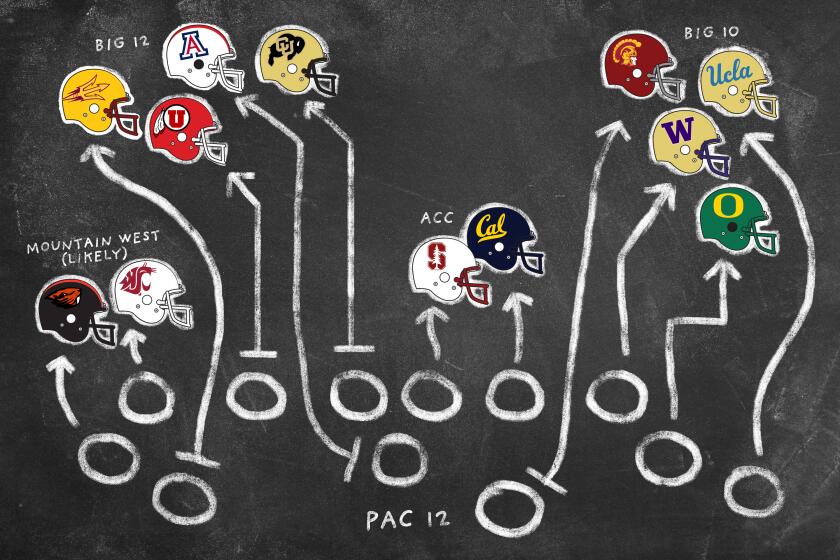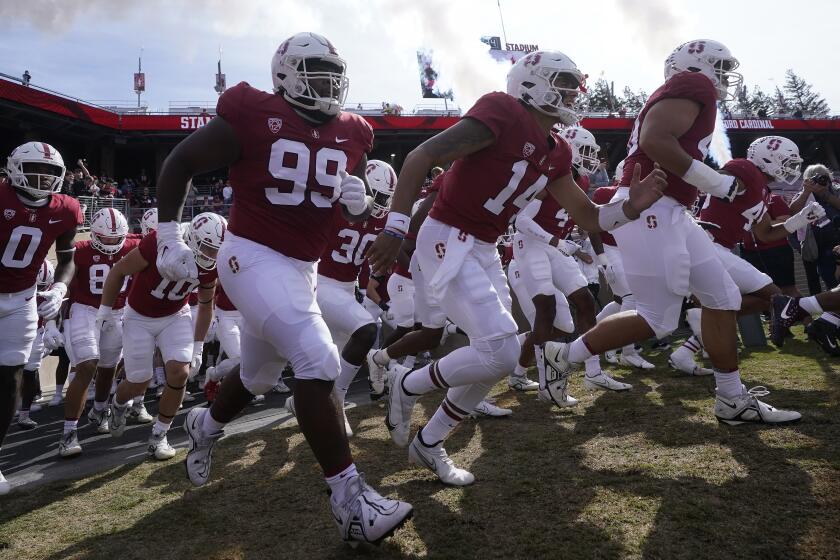Stanford, Cal and SMU join the ACC, potentially cementing the death of the Pac-12

- Share via
The Pac-12’s steady march toward its death appears to be nearing an end, with Stanford, California and Southern Methodist announcing they are joining the Atlantic Coast Conference in 2024.
Yes, the Cardinal and Golden Bears will soon be part of a conference with headquarters in North Carolina.
Yes, it happened one day after Charter’s dispute with Disney caused Spectrum customers throughout the Pac-12 footprint to lose access to ESPN and major opening weekend college football games.
And yes, it leaves just two schools — Washington State and Oregon State — in what has become the Pac-2.
Last year, UCLA and USC shocked the college sports landscape by announcing their move to the Big Ten. The Times reported Pac-12 university presidents and chancellors clashed over how to move forward, spurning potential media rights deals with ESPN and Apple that could have stabilized the conference.
How did the Pac-12 die? These surprising decisions by USC, Oregon, Washington and others thwarted efforts to save the conference.
Tiring of the instability that continued for a year, Colorado defected to the Big 12 in July. Washington and Oregon joined the Big Ten in August, receiving smaller television revenue shares than the Bruins and Trojans, and Arizona, Arizona State and Utah jumped to the Big 12 the next day. All the schools are set to depart the Pac-12 at the end of the 2023-24 academic year.
Washington State and Oregon State leaders have denounced conference affiliations that make no geographic sense and are evaluating their options. But their next move is unclear.
The American Athletic Conference, home to SMU, announced Friday it would not explore expansion and effectively closed the door on Oregon State and Washington State before they could even knock.
While most industry observers expect the schools to join the Mountain West Conference, the San Jose Mercury News reports Oregon State and Washington State plan to take their time reviewing legal options because they could retain significant revenue they no longer have to split with departing members should they find a way to keep the Pac-12 name alive. One scenario could include absorbing the Mountain West rather than joining it.
Stanford and Cal leaders opted for a different solution after they found themselves among the final four remaining Pac-12 members.
After promising to take steps to reduce the travel burden on athletes, including playing tournaments in central locations, and lauding the ACC’s strong academic reputation, Stanford acknowledged this move largely came down to money. The Cardinal will likely receive more from the ACC than it would from any other option, including helping rebuild the Pac-12.
The cause of death was massive hemorrhaging, with 10 schools announcing plans to depart the conference in 2024.
“Conference affiliations and the broadcast revenue they generate provide key financial support for the wide array of sports that Stanford offers,” Cardinal athletic director Bernard Muir said in a statement. “Joining the ACC will ensure the power conference competitive infrastructure and long-term media revenues that are critical for our student-athletes to compete.”
Cal’s announcement about its move to the ACC projected 19 of the Golden Bears’ 30 sports will experience either no or minimal change in travel mileage. The school, which fought UCLA’s move to the Big Ten due to what it called an undue travel burden on athletes, announced Friday it will explore measures to minimize the effect travel could have on its athletes.
“We made this decision in the best interests of our student-athletes, the university and our extended Cal community of alumni and supporters,” Cal Chancellor Carol Christ said in a statement.
It wasn’t a smooth transition to the ACC for Stanford and Cal.
The schools needed 12 of 15 current ACC members to agree to admit them and it took a month of lobbying to earn the votes.
Notre Dame, which has a partnership with the ACC while remaining independent in football, reportedly campaigned to get Stanford and Cal into the conference, but Clemson, Florida State, North Carolina and North Carolina State objected to expansion. After promises the new schools would take less TV revenue than other ACC schools, ESPN reported N.C. State flipped and provided the 12th vote required to invite Stanford and Cal to the conference.
With Stanford and California joining USC, UCLA and six other schools in fleeing the Pac-12, the one-time power conference could be no more by next year.
SMU is expected to join the ACC for nine years with no broadcast media revenue, ESPN reported, while Cal and Stanford were expected to receive 30% shares of ACC media rights payouts for the first seven years. The Mustangs would still receive a share of the league’s College Football Playoff revenue.
Florida State has been especially vocal opposing expansion and has threatened to leave the ACC, signaling the seismic shifts that began two years ago when Texas and Oklahoma agreed to leave the Big 12 to join the SEC may not be over.
For now, even those who opposed ACC expansion are embracing the coast-to-coast conference makeover.
“There are many complicated factors that led us to vote no,” Florida State president Richard McCullough said in a statement. “That said, we welcome these truly outstanding institutions and look forward to working with them as our new partners in the Atlantic Coast Conference.”
Commentary: Stanford and Cal’s ACC move all about a blind devotion to money, not ‘student-athletes’
With Stanford and Cal moving to the ACC, university presidents continue to put the football money train ahead of what is in the best interest of students.
More to Read
Go beyond the scoreboard
Get the latest on L.A.'s teams in the daily Sports Report newsletter.
You may occasionally receive promotional content from the Los Angeles Times.
















